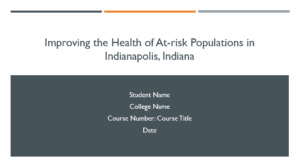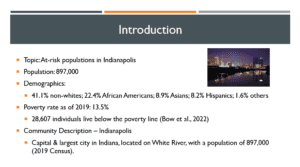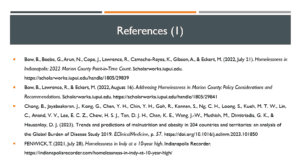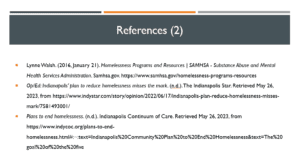Improving the Health of At-risk Populations in Indianapolis, Indiana
Hello, everyone. My name is [name], and I am here to talk about at-risk populations in Indianapolis, Indiana, and how nurses can support them effectively. Before we start, I would like to put it into context: Indianapolis has a total population of 897,000. Regarding demographics, 41.1% of the population is non-white, with 22.4% African Americans, 8.9% Asians, 8.2% Hispanics, and 1.6% others. In terms of the poverty rate, the 2019 estimate was 13.5%, with 28,607 individuals living below the poverty line (Bow et al., 2022).
Community Description – Indianapolis, Indiana, is the capital of the state and the most populous city in Indiana. It is located on the White River and has a population of 897,000, according to the 2019 U.S. Census. The city is divided into six economic regions and has a vibrant cultural life.
The needs assessment of at-risk groups in Indianapolis, Indiana, is centred on the homeless population. According to a recent analysis conducted by the United States Government Accountability Office (US GAO) in 2020, there appears to be a positive correlation between the cost of rental properties and the prevalence of homelessness in urban areas. Specifically, the study found that for every $100 increase in median monthly rent, there was a corresponding 9% increase in the number of individuals experiencing homelessness (Bow et al., 2022). IndyGo, an Indianapolis Public Transportation Corporation subsidiary, facilitates transportation services. Bow et al. (2022) have elucidated that preferential pricing schemes are extended to Medicaid beneficiaries, veterans, and individuals from underprivileged economic backgrounds. In the realm of nutritional initiatives, it has been observed that Indianapolis exhibits a relatively elevated level of engagement compared to its surrounding environs and has experienced a modest increase in participation from 2010 to 2020, as per the findings of Bow et al. (2022).
The most significant health disparity of the homeless population in Indianapolis, Indiana, is malnutrition. As per the findings of Bow et al. (2022), the current state of homelessness is characterized by a population of 1,190 individuals, of whom 910 have been provided with housing while 280 remain unsheltered. Malnutrition may result in compromised immune function, heightened susceptibility to infections, and psychological disturbances. Furthermore, individuals’ heightened utilization of emergency services places a significant burden on hospital resources, as Fenwick (2021) reported. The prevalence of malnutrition is pervasive in various nations, particularly in Africa and low SDI regions, as evidenced by the significant burden of DALYs. Meanwhile, Eastern Mediterranean and moderate SDI countries exhibit the highest rates of obesity-related DALYs, according to Chong et al.’s (2023) research. To address this health disparity, nurses must assess patient nutrition status to guide personalized dietary interventions. Additionally, nurses should collaborate with local food pantries or homeless shelters to extend nutritious meals in alignment with limited funds. Further, advocates are necessary to reduce socio-economic disparities, increase access to nutritious meals, and counter the underlying causes of malnutrition.

The Coalition for Homelessness Intervention & Prevention (CHIP) is dedicated to preventing and ending homelessness in Indianapolis. The organization employs an outreach coordinator who actively engages with people experiencing homelessness through case management, street outreach, and supportive services. Obstacles are effectively overcome through empathy, attentive listening, and a persistent state of being. Favourable consequences stemming from their outreach endeavours encompass a recently efficacious rapid rehousing initiative, which facilitated the acquisition of stable housing for an individual experiencing homelessness. The dearth of reasonably priced housing, joblessness, and inadequate social welfare provisions are three salient determinants contributing to homelessness. The issues above are being tackled by providing legislative assistance for housing, establishing workplace partnerships, and implementing support programs (“Op/Ed: Indianapolis’ plan to reduce homelessness misses the mark”, n.d.).
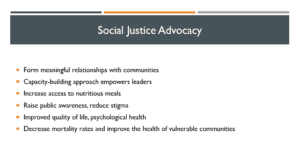
In conclusion, nursing professionals possess the potential to significantly contribute to the advancement of social equity for vulnerable communities residing in Indianapolis, Indiana. This encompasses a comprehensive comprehension of the social determinants of health, the ability to discern health disparities and inequities, the capacity to identify the requirements of susceptible populations, and the aptitude to establish collaborative relationships with community-based organizations. Through these endeavours, nurses can effectuate significant transformation and enhance the well-being of vulnerable demographics.
¡Bow, B., Beebe, G., Arun, N., Cope, J., Lawrence, R., Camacho-Reyes, K., Gibson, A., & Eckert, M. (2022, July 21). Homelessness in Indianapolis: 2022 Marion County Point-in-Time Count. Scholarworks.iupui.edu. https://scholarworks.iupui.edu/handle/1805/29839
¡Bow, B., Lawrence, R., & Eckert, M. (2022, August 16). Addressing Homelessness in Marion County: Policy Considerations and Recommendations. Scholarworks.iupui.edu. https://scholarworks.iupui.edu/handle/1805/29841
¡Chong, B., Jayabaskaran, J., Kong, G., Chan, Y. H., Chin, Y. H., Goh, R., Kannan, S., Ng, C. H., Loong, S., Kueh, M. T. W., Lin, C., Anand, V. V., Lee, E. C. Z., Chew, H. S. J., Tan, D. J. H., Chan, K. E., Wang, J.-W., Muthiah, M., Dimitriadis, G. K., & Hausenloy, D. J. (2023). Trends and predictions of malnutrition and obesity in 204 countries and territories: an analysis of the Global Burden of Disease Study 2019. EClinicalMedicine, p. 57. https://doi.org/10.1016/j.eclinm.2023.101850
¡FENWICK, T. (2021, July 28). Homelessness in Indy at a 10-year high. Indianapolis Recorder. https://indianapolisrecorder.com/homelessness-in-indy-at-10-year-high/
¡Lynne Walsh. (2016, January 21). Homelessness Programs and Resources | SAMHSA – Substance Abuse and Mental Health Services Administration. Samhsa.gov. https://www.samhsa.gov/homelessness-programs-resources
¡Op/Ed: Indianapolis’ plan to reduce homelessness misses the mark. (n.d.). The Indianapolis Star. Retrieved May 26, 2023, from https://www.indystar.com/story/opinion/2022/06/17/indianapolis-plan-reduce-homelessness-misses-mark/7581493001/
¡Plans to end homelessness. (n.d.). Indianapolis Continuum of Care. Retrieved May 26, 2023, from https://www.indycoc.org/plans-to-end-homelessness.html#:~:text=Indianapolis%20Community%20Plan%20to%20End%20Homelessness&text=The%20goal%20of%20the%20five
ORDER A PLAGIARISM-FREE PAPER HERE
We’ll write everything from scratch
Question
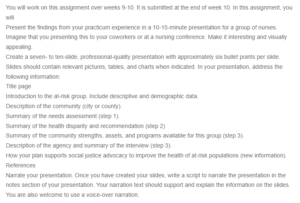
Improving the Health of At-risk Populations in Indianapolis
You will work on this assignment over weeks 9-10. It is submitted at the end of week 10. In this assignment, you will
Present the findings from your practicum experience in a 10-15-minute presentation for a group of nurses. Imagine that you presenting this to your coworkers or at a nursing conference. Make it interesting and visually appealing.
Create a seven- to ten-slide, professional-quality presentation with approximately six bullet points per slide. Slides should contain relevant pictures, tables, and charts when indicated. In your presentation, address the following information:
Title page
Introduction to the at-risk group. Include descriptive and demographic data.
Description of the community (city or county).
Summary of the needs assessment (step 1).
Summary of the health disparity and recommendation (step 2)
Summary of the community strengths, assets, and programs available for this group (step 3).
Description of the agency and summary of the interview (step 3).
How your plan supports social justice advocacy to improve the health of at-risk populations (new information).
References
Narrate your presentation. Once you have created your slides, write a script to narrate the presentation in the notes section of your presentation. Your narration text should support and explain the information on the slides. You are also welcome to use a voice-over narration.

